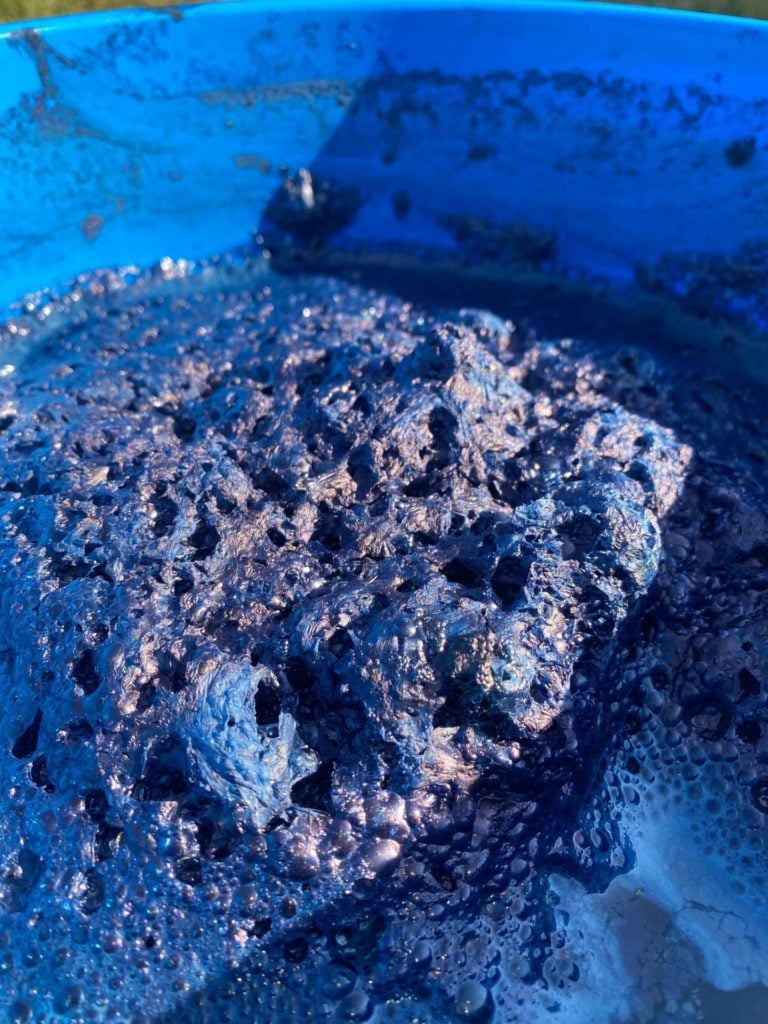Our indigo instructions originally used a recipe based on Michel Garcia’s 1-2-3 vat, created nearly 10 years ago. Since then, we’ve made some changes and developed different recipes that will allow you to control how light or dark your vat is.
Types of Vats:
There are three main types of vats that you can build. Use the indigo instructions below to decide which one is best for you.
| Vat type | About | Advantages | Disadvantages |
| Fructose | Clearest blue | Dyes lighter than henna or iron | Seems to perform best when aged for 2-3 days, and when warmed before use. |
| Henna | Warmest blue/yellow cast | Dyes darker colors in fewer dips | Requires extra step to set up as the henna should be dissolved and strained separately. Benefits from a 3 day aging. |
| Iron | Coolest blue/gray cast | Dyes darker colors in fewer dips Can be used at room temperature without reheating | Recommended for adults only as iron is unsafe for babies, children and pets. Should not be used with silk or wool as it can damage the fibers |
Vat Recipes:
How to Make a 1-2-3 Fructose Indigo Vat
How to Make a 1-2-3 Henna Indigo Vat
How to Make a 1-2-3 Iron Indigo Vat
For more details on the different types of vat and how they compare to each other, see our deep dive into all four vats on our blog.
Shop our Organic indigo.


How long does it take for the stock to begin fermenting? An hour? A day? Two days? I’m trying to plan a dye day with some friends, and am not certain if I should make the vat in advance or on the day we plan to dye.
I will be using henna to start the bath and fructose to maintain it.
We love to give it two days to really get ready for dyeing!
Hi, I was really searching for that info too–if possible (I know wordpress can be a pain to do changes!), but it would be great to have the steep time for the indigo stock in the instructions. If you’re new to making it , you honestly have no idea if you should see a change in a matter of minutes, hours or days.
Thanks, so much great info on this site!
How would you recommend re-balancing the Vat if you have it in a big plastic bucket? How much fruit sugar should I start with and then how much lime ? I added 140degree water to the vat, since I couldn’t put it on the stove again. Any thoughts?
Hi Carolin,
Head to our “How To” for indigo and see how: https://botanicalcolors.com/indigo-instructions/
Best,
Amy
I’ve just found a 5-gallon pickling crock, which I think will make an excellent indigo vat. I’m still an indigo tyro, so I don’t know if keeping a vat going in a crock is a good idea.
Is an outside heat source absolutely necessary? Can patience and solar heating substitute? I was planning to set it up ouside in a part-shade area to prevent overheating during hot Texas summers. Winters here are pretty mild and I’m willing to forego indigo dyeing if temps drop and the vat hibernates.
Alternatively I can invest in a suitable heat source such as a stock bucket heater or aquarium heater, if either would be appropriate.
Thanks for any feedback!
Hi Michelle,
I’ve been indigo dyeing for years without reheating the vat and it works, just a little slower than if you heat it. That said, Texas is hot!! Put it out in the sun and let nature do its thing!
-Amy
Hello,
I have a 5 gallon fructose vat.
My niece is bringing Hoffman Radiance fabric up to dye in it. Radiance is 55% cotton and 45% silk. Do I scour as if silk or scour as if cotton? If I scour as if silk, do I still use the vinegar rinse and do I need to mordant with alum? Normally, I dye cellulose fibers and don’t mordant after scouring. Any suggestions are greatly appreciated. I don’t want to ruin the fabric or the beautiful color!
And, FWIW, I’m in Seattle and I’ve been dyeing outdoors in dappled sun without reheating the vat. It takes an extra dip or two to get deeper colors than with a heated vat, but it’s summer and it’s indigo and an extra couple dips is just more fun.
Thank you!
Cynthia
Hi Cynthia,
If the fabric is Radiance PFD there should not be a need to scour. And no need to mordant until after indigo and only if you wants to overdye it with a natural dye.
Best,
Amy